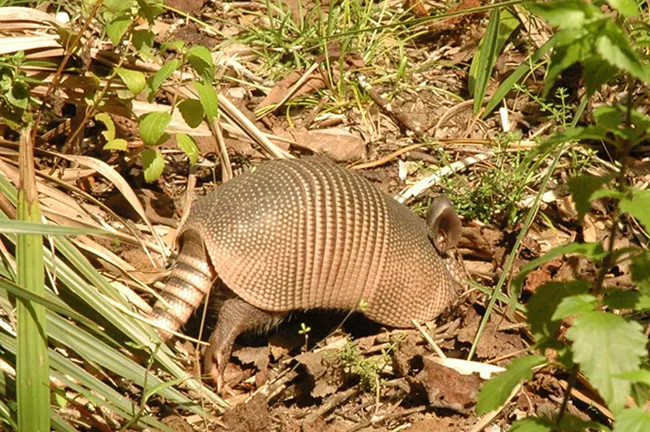
wayward male armadillos reached Virginia in 2019
Source: US Fish and Wildlife Service, Nine-banded armadillo

wayward male armadillos reached Virginia in 2019
Source: US Fish and Wildlife Service, Nine-banded armadillo
The first official sighting of an armadillo in Virginia occurred in 2019. A Nine-banded armadillo was collected in Russell County and sent to the Virginia Museum of Natural History, which prepared it as a museum specimen as one of the naturally-occurring species in Virginia.1
The armadillo, or "little armored thing," evolved in South America around fifty million years ago when that continent was unconnected to North America. When tectonic forces pushed up the land bridge at Panama three million years ago, armadillos and other South American species migrated into North America. The original migrant, the beautiful armadillo (Dasypus bellus), was 200-250% larger than today's Nine-banded armadillo. It reached Missouri, Iowa and Nebraska, but went extinct 11,000 years ago.
No Nine-banded armadillos were known north of the Rio Grande before 1850. Though the animals have a high reproductive rate, regularly birthing identical quadruplets, they are slow movers and poor swimmers.
The arrival of American settlers in Texas led to suppression of both prairie fires and hunting by Native Americans, while creating bridges across rivers that were major barriers to armadillo movement. At least some armadillos crossed the dry lands north of Mexico by hitchhiking on trucks and railroad cars, while a population was introduced into Florida after escaping from a zoo and a traveling circus in the 1920's and 1930's.
Armadillos evolved as South American jungle animals. The expansion of their range is constrained by cold weather and drought; they live only in places where the average January temperature is above 28°F and there is regular access to fresh water. Since armadillos dig for food, they can no survive where the ground remains frozen.
There is suitable habitat for armadillo expansion up to New York and Cape Cod; the main challenge for armadillos living in Virginia is getting here. Males are known to explore beyond settled territories, and reproducing colonies get established later.2
In 1986, the Farmville Herald reported that an armadillo had been killed in Prince Edward County by a car. Armadillo means "little armored thing" in Spanish, but it is extremely vulnerable to cars. Due to the number killed by cars, they are jokingly described as an "organic speed bump." The primary defense mechanism, other than bony plates that coat the body, is to leap when attacked and then run away at an angle different from the predator's approach:3

an armadillo was found near Farmville in 1988
Source: Virginia Chronicle, Farmville Herald (March 2, 1988)
The first confirmed sighting in North Carolina was in 2007. Starting in 2019, armadillo sightings became common in Southwest Virginia.
Most were recognized after being hit by vehicles, becoming "possums on the half shell." One was spotted seen digging in a garden; one was killed by a dog, and one was caught on a trail camera. An armadillo was sighted on a back patio in Roanoke in 2021.
By 1954, armadillos had crossed the Mississippi River. By 1972, they were in Georgia. The potential expansion of the armadillo range was estimated to be nearly seven miles annually. Like an earlier immigrant from South America, the possum, all of Virginia was suitable habitat for the armadillo. As one news story described the potential: 4

armadillos are diggers, and live in areas where the ground is not frozen for long periods of time
Source: National Park Service, Armadillos